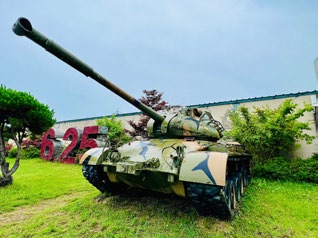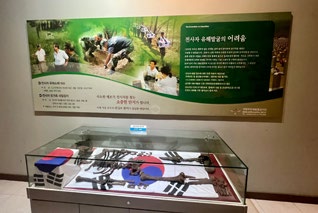Sokcho Travel Guide: Where Mountains Meet the Sea – Nature, Reflection, and Discovery
- Jetta Allen

- Jul 3
- 6 min read

For service members and their families stationed in Korea, time off is precious — a chance to decompress, reconnect, and explore the incredible blend of nature, culture, and history this country offers. If you're looking for a weekend destination that captures Korea’s mountain views, historical depth, and coastal beaches all in one, set your sights on Sokcho. Whether you're planning your first visit or returning for another peaceful escape, consider this your Sokcho travel guide to discovering the region’s natural beauty and cultural depth.
What to Expect in Sokcho: Nature, Culture, and Coastal Charm
Located on Korea’s northeastern coast in Gangwon Province, Sokcho is a rare gem — a city where the dramatic peaks of Seoraksan National Park spill down toward the East Sea, and where the line between adventure and serenity is delightfully blurred. Sokcho offers something unique: a space where the mountains meet the beach, the past meets the present, and the edge of one world brushes against another. Our trips to Sokcho never disappoint!

Seoraksan National Park: Sokcho’s Must-Visit Natural Treasure
The centerpiece of Sokcho’s natural allure is undoubtedly Seoraksan National Park. As a UNESCO-designated biosphere reserve and one of Korea’s most celebrated hiking destinations, it should be on everyone’s Korea bucket list. What's even better is that it is just minutes from downtown Sokcho! Within the national park are over 1,500 species of animals and over 1,000 species of plant life. Seoraksan’s granite spires, lush forests, and well-marked trails cater to every kind of explorer, from casual strollers to serious climbers. Trails also vary in composition, some being paved, others gravel, dirt, or made of a collection of large or small stones. This national park has something for all ability levels and can accommodate a wide range of accessibility needs. If you are using a stroller, walker, or wheelchair, some trails and paths can accommodate you as well!

Tucked within Seoraksan National Park is Sinheungsa Temple, a serene sanctuary that offers more than just a peaceful rest stop for hikers — it carries deep cultural and symbolic weight. Near its gates stands the Unification Great Buddha, an immense bronze statue that is a symbol of hope for peace and reunification of Korea. Inside the statue are sacred relics, including depictions of the Thousand-Handed Avalokitesvara, representing compassion and protection. Surrounding the Buddha are stone Arhats, each posed in meditation, reinforcing the message of unity and reflection.
Top Things to Do in Seoraksan National Park for All Skill Levels

If you’re an adventurer, head up the scenic trail within Seoraksan National Park that leads to Biryong Falls, a waterfall named for the "flying dragon" it is said to resemble as it crashes down the rocks. While the walk starts easily enough, about halfway up, the easy trail becomes more challenging. The trail drastically becomes steeper and more rugged, requiring a climb over large rocks. This trail became a personal challenge for me that was met with cheers as we made it to the top!
If you're not up for a steep trek, the Seoraksan Cable Car makes it easy to experience panoramic views of the Gwongeumseong Fortress and many mountain ranges. The ride lifts you high above the forest canopy, offering a stunning aerial perspective of the park with its mountains, temples, and the East Sea shimmering beyond. In spring, summer, fall, or winter, the view provides a moment of awe worth remembering.

Sokcho Beach Travel Tips and the Sokcho Eye Experience
After the heights of Seoraksan, wind down with a stroll along Sokcho Beach, known for its clean sands and clear blue waters. Unlike Korea’s more crowded southern shores, Sokcho Beach has a laid-back feel that makes it perfect for relaxing or watching the sun rise dramatically over the sea.

Nearby, the Sokcho Eye, a 65-meter-tall Ferris wheel, offers an unexpected but welcome shift in perspective. From your enclosed bubble capsule, you slowly make your way up, taking in the views of the coastline, cityscape, and mountains — all within a single, but slow turn. It’s a reminder of how Sokcho elegantly bridges nature and urban life. I recommend riding the Sokcho Eye at sunset!

One of my fondest memories from our trip to Sokcho Beach was my son enjoying the sun and sand. No shovels. No toys. No squirt guns. Just his hands digging in the sand, playing with his dad. As I watched, they soon hatched a plan to bury me in the sand. Thankfully, they didn’t want to cover me completely!
Where to Eat in Sokcho: Seafood Markets, Street Food, and Local Favorites
In Sokcho, seafood isn’t just a meal, it’s a ritual. At dawn, the piers hum with the clatter of fishmongers setting up stalls, trays brimming with glistening crab and plump, translucent shrimp still wriggling with freshness. Sokcho's famed red snow crab has a sweet, briny, and buttery taste that is the crown jewel of any meal. It’s best enjoyed freshly steamed with a side of dipping salt and a cold glass of soju. Shrimp lovers, meanwhile, flock to street vendors near Jungang Market, where skewers sizzle over open flames, brushed with garlicky or chili marinades that caramelize into perfection. My favorite was the tropical shrimp boxes with tasty shrimp, fruit, and a slice of garlic bread.

DMZ Unification Observatory Near Sokcho: A Meaningful Day Trip
Just a short drive north of Sokcho lies a place that brings Korea’s complex past and ongoing tension into sharp focus: the DMZ Unification Observatory near Goseong. Here, from fortified observation decks, visitors can look across the border into North Korea — a surreal and sobering experience. The observatory offers a rare glimpse at one of the most heavily guarded borders in the world, while also promoting messages of peace, hope, and reunification. For military personnel and their families, especially, it’s a meaningful stop that grounds the reality of our mission here in Korea.

Understanding the DMZ: A Sokcho Day Trip That Brings History into Focus
Just minutes from the DMZ Unification Observatory, the 6.25 War Memorial Museum offers a sobering and informative look at the Korean War, known locally as the "6.25 War" because of its June 25th start date. Through exhibits, artifacts, and multimedia displays, the museum traces the conflict’s impact on the peninsula and the enduring legacy of division. It's a powerful stop that adds context to the nearby border views, reminding visitors that the scenery comes with a history not to be forgotten. Inside one display case are the remains of a recovered soldier—a powerful, quiet tribute to the profound human cost of the Korean War. A nearby sign notes that over 130,000 fallen soldiers were left behind in Korea’s mountains and fields, and to date, only about 1% have been recovered. Countless others remain missing, with ongoing efforts to return them to their families and honor their sacrifice.
Throughout our time in Korea, we have visited many locations along the DMZ, including the Joint Security Area. I strongly urge all readers to visit somewhere along the DMZ at least once during your time in Korea. With each visit, we’ve gained deeper insight into Korea’s past and how so many are waiting to one day reunite with friends, loved ones, and distant relatives.
Why Visit Sokcho? A Korea Travel Guide for Nature, History, and Family Fun
Sokcho is more than a tourist spot — it’s a destination that seems to renew my soul with each visit. Whether you're in the mood to chase mountain trails, unwind by the sea, or take in the weight of Korea's history just miles from the border, Sokcho offers it all in one unforgettable destination.
It’s easy to reach from most installations via car or bus, making it an ideal weekend escape. Whether you're savoring a bowl of fresh seafood stew at a harbor-side market, standing atop a wind-blasted ridge in Seoraksan, or quietly gazing across the DMZ, Sokcho leaves an impression — one that lingers long after you’ve returned home.
In Sokcho, nature and history collide beautifully. Visit Sokcho, whether you're a single adult, a couple, or here with children; everyone can enjoy this area. It’s where you can truly feel the heart of Korea, from the mountaintop to the shoreline, and all the way to the horizon.








1 Comment